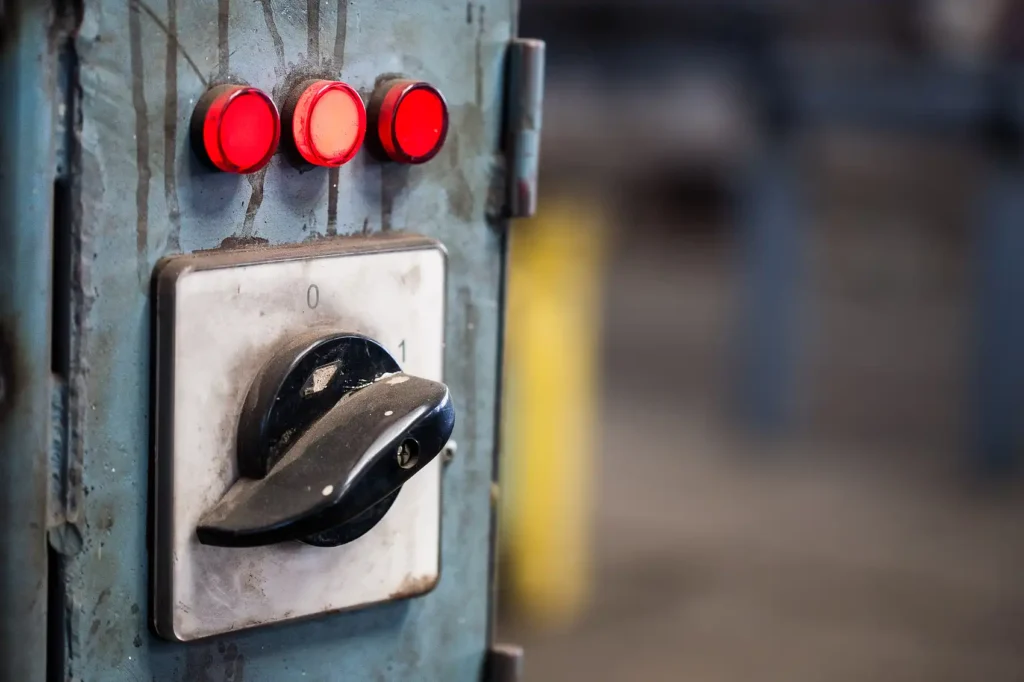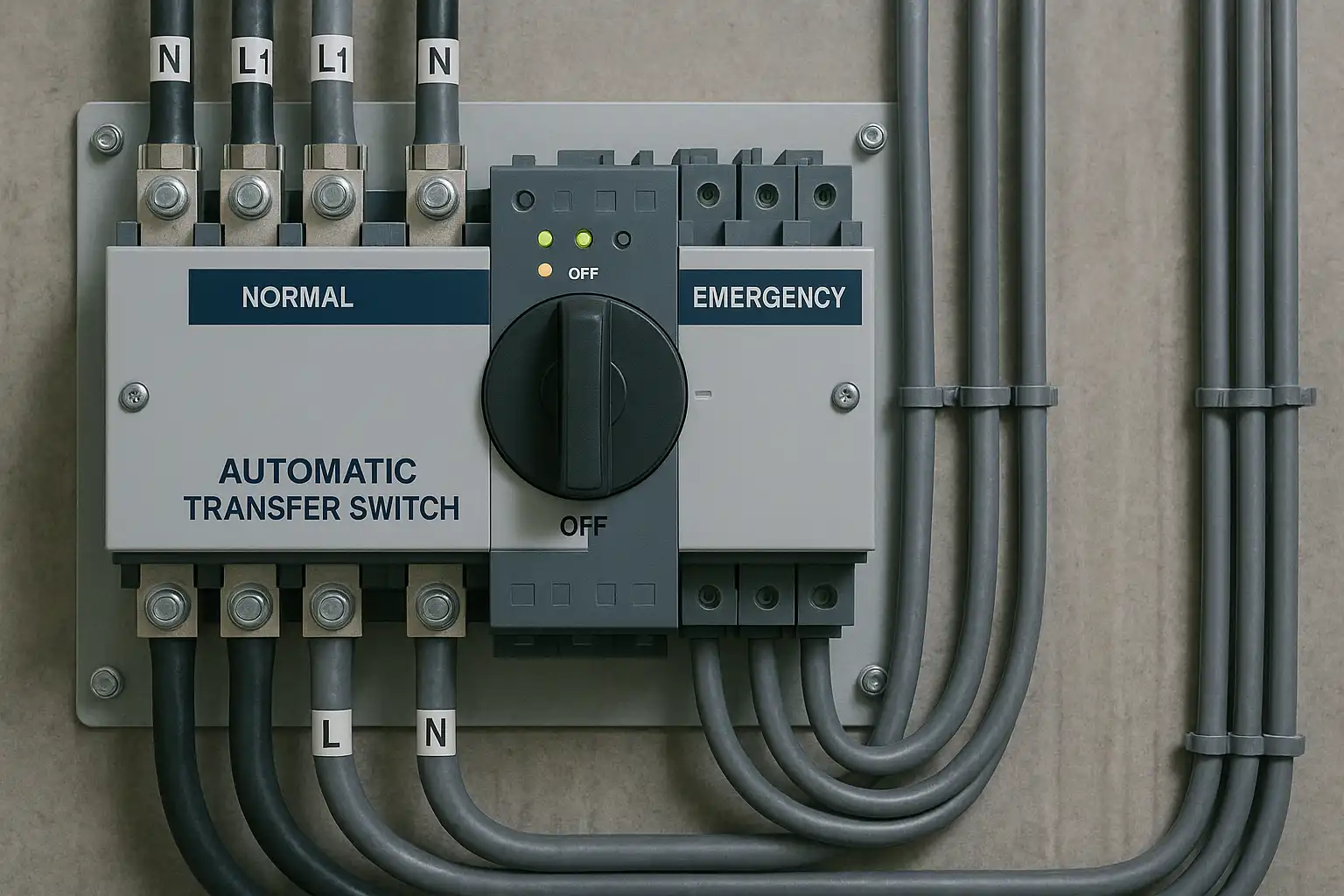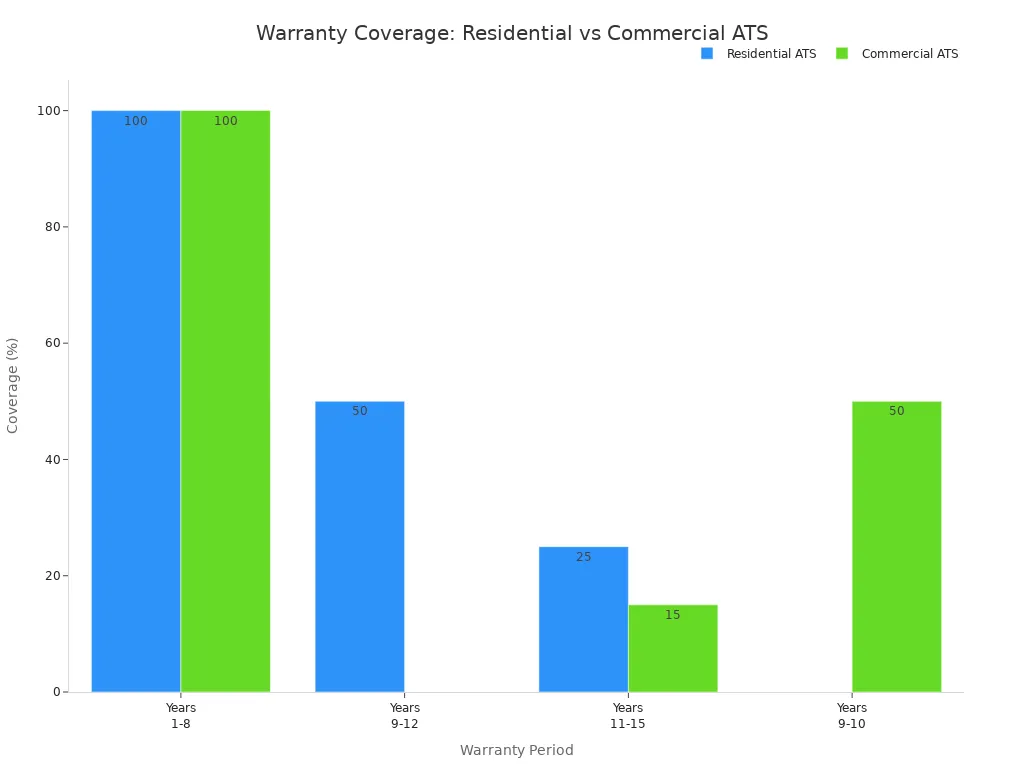You will notice a significant price difference when comparing Residential vs. Commercial ATS. Commercial ATS systems are more expensive because they manage higher power loads, come with advanced features, and require more complex installation. The higher cost reflects their larger capacity and more durable construction. For backup power in a small home, a residential ATS is more affordable. However, if you operate a business or manage a large building, a commercial ATS is necessary to provide greater power and enhanced safety. Your specific needs and budget will guide you in choosing the right system.
Key Takeaways
- Commercial ATS units are more expensive. They handle more power. They have special safety and control features.
- Residential ATS units cost less. They work well for homes or small offices. These places do not need as much power.
- Installing commercial ATS is harder. It takes more time. It costs more money. This is because of higher voltage and safety rules.
- Picking the right ATS depends on your building size. It also depends on how much power you need. Your budget matters too. This helps make sure you have backup power.
- Extra features and smart maintenance can make ATS cost more. But they help save money later. They also keep equipment safe over time.
What Is an ATS?
Basic Function
An Automatic Transfer Switch (ATS) helps keep your power on. It works when your main power stops working. You do not need to do anything. The ATS checks the voltage and frequency of your main power. If it finds a problem, it switches to backup power, like a generator. This switch happens very fast. Your lights and computers stay on without stopping.
Note: The ATS uses a smart controller to watch your power all the time. It can tell if the voltage is low or if the power goes out. When this happens, the ATS connects your backup power right away. When your main power comes back, the ATS switches you back. This keeps important equipment safe in places like hospitals, data centers, and homes.
You can find ATS devices in many places. In homes, they keep your fridge and lights working during storms. In businesses, they stop computers and machines from turning off. The ATS makes sure you have power, even if the main source fails.
Why Price Varies
You may wonder why some ATS units cost more than others. The price depends on a few important things:
- Power Capacity: Home ATS units handle less power. Commercial ATS units manage much bigger loads for large buildings or factories.
- Features: Some ATS models only switch power. Others have extra features like load management, surge protection, and remote monitoring.
- Installation Complexity: Installing a home ATS is usually easy. Commercial ATS units need experts and must follow strict rules.
- Design and Durability: Commercial ATS units use stronger parts. They last longer and work in tough places.
Here is a table to show the main differences:
| Aspect | Residential ATS | Commercial ATS |
|---|---|---|
| Power Requirements | Lower, for household loads | Higher, for business and industrial loads |
| Features | Basic automatic switching | Advanced control, monitoring, and protection |
| Installation | Easier, less wiring | Complex, needs expert knowledge |
| Cost | Lower | Higher |
| Typical Applications | Homes, small offices | Large buildings, factories, data centers |
You pay more for a commercial ATS because it does more and lasts longer. The extra money pays for better features, higher power, and safer use. When you pick an ATS, think about your power needs, the features you want, and your budget.
Residential ATS Overview
Residential ATS Costs
You might ask why residential ATS units cost what they do. The main reason is the technology and safety they give your home. Most residential ATS units cost between $3,439.00 and $4,226.00. This price pays for good performance, safety, and easy setup. You pay for peace of mind when the power goes out, especially in bad weather.
Here is a table that shows a popular residential ATS series and its price range:
| Product Series | Application Type | Price Range (USD) | Notes |
|---|---|---|---|
| ASCO 185 Series Residential ATS | Residential | $3,439.00 – $4,226.00 | Made for home generators; small size; can be used inside or outside; different models for service entrance or not |
Models with more features or stronger build cost more. The price also covers safe, automatic switching to protect your home and devices.
Key Features
You may wonder why residential ATS units have certain features. These features make things easier and keep your home safe. Most residential ATS units include:
- Built-in switch and controller for easy use
- Quick and simple setup with little wiring
- Manual use under load without opening the door
- Snap-on add-ons for more functions without tools
- Parts you can change and check to avoid long repairs
- Smart connections for future upgrades
Many models also have automatic power transfer, work with generators, and have cases that do not rust. You can use them inside or outside, manage loads, and get a 5-year warranty. These features help keep your home powered and safe, even in storms.
Thomson Power Systems says residential ATS units help you stay comfortable, safe, and green during outages. You can trust these systems to keep your lights and appliances working.
Typical Uses
You might ask why people pick residential ATS units. Homeowners use them to keep important things running during blackouts. You can protect your fridge, heat, and security system. Many people get residential ATS units to stop food from going bad, keep their homes safe, and stay comfortable in storms.
You will see these systems in houses, small offices, and places where power is important. If you want backup power that works by itself, a residential ATS is a simple and good choice.
Commercial ATS Overview
Commercial ATS Costs
You might notice commercial ATS units cost a lot more. This is because they handle big power loads for businesses. They keep your business running when the power goes out. Commercial ATS units usually cost from $5,000 to over $20,000. The higher price pays for stronger parts and better safety. These units can switch power for large buildings or factories. You also pay for expert setup and strict safety rules. Picking a commercial ATS means you get reliable power and protection for your business.
Advanced Features
You may wonder why commercial ATS units have many extra features. These features help keep important systems working and follow safety rules. For example, Eaton’s commercial ATS models bring back power to life safety areas in 10 seconds. This is very important in hospitals. Some models, like Siemens RTSCD, have service entrance ratings. This means you get automatic power switching and safe disconnecting in one unit.
Most commercial ATS units include:
- Fast switches that change power quickly
- Manual controls for emergencies
- Easy access to parts for quick fixes
- Smart controllers with screens and settings you can change
- High current and voltage ratings for big systems
- Open or closed transition switching with phase checks
- Strong, covered contacts for safety and long use
- Meet strict rules like UL 1008 and NFPA 110
Tip: These features help stop downtime, protect equipment, and follow building codes.
Typical Uses
You might wonder why businesses pick commercial ATS units. You need them when losing power is not an option. Hospitals use commercial ATS to keep life-saving machines on. Data centers use them to protect servers and data. Factories use them to stop costly shutdowns. Schools, offices, and big stores also use commercial ATS to keep lights and computers on during outages.
- Hospitals and healthcare centers
- Data centers and server rooms
- Factories and manufacturing plants
- Large office buildings and schools
- Shopping malls and supermarkets
You pick a commercial ATS when you need strong backup power for important work. This keeps your business safe, legal, and ready for anything.
Residential vs. Commercial ATS Comparison
Price Differences
You might wonder why commercial ATS costs so much more. The main reason is that commercial ATS units handle more power and have extra features. When you look at the prices, the gap is clear.
| ATS Category | Current Rating Range (Amps) | Price Range (USD) | Notes |
|---|---|---|---|
| Residential ATS | 6 to 63 | $188.92 to $685.77 | Lower current ratings, compact size, suitable for homes and small offices. |
| Commercial ATS | 100 to 800+ | $436.85 to $1,599.21 | Higher current ratings, robust design, for businesses, factories, and critical sites. |
Commercial ATS units cost more because they power bigger buildings and more devices. As the current rating and features go up, so does the price. Brands like Honeywell and Cummins show this price jump. For example, a Honeywell 200A residential ATS costs about $719 to $869. A Cummins commercial ATS with a similar amp rating can cost $3,344 to $7,135. This happens because commercial units must be stronger and safer.
Features and Capacity
You may ask why commercial ATS units have more features and higher capacity. Businesses and important places cannot lose power. They need more protection and control.
| Feature | Residential ATS (LiftMaster ATSW) | Commercial ATS (CNC Electric) |
|---|---|---|
| Voltage | 120V, Single Phase | AC 400V, Three Phase |
| Rated Current | Up to 63A | 10A to 800A (up to 3200A in some models) |
| Protection Features | Basic safety, UL 325 | Overvoltage, Undervoltage, Phase Protection |
| Operation Modes | Automatic | Automatic / Manual |
| Connectivity | Smartphone, HomeLink | Advanced control, monitoring |
| Application | Homes, light commercial | Industrial, commercial, critical infrastructure |
Commercial ATS units give more because they protect expensive equipment and keep things running. You get features like phase protection, higher voltage, and strict rules. Residential ATS units focus on simple, automatic switching for your home. You get smartphone control and easy setup, but not the heavy-duty features.
Tip: If you need to protect important equipment or run a big building, pick a commercial ATS for its extra features and higher capacity.
Installation and Labor
You might wonder why it costs more to install commercial ATS. The answer is that the job is bigger and harder.
| Cost Item | Typical Cost Range |
|---|---|
| ATS Installation (Residential) | $600 – $2,500 |
| Electrician Labor Rate | $40 – $100 per hour |
| ATS Installation (Commercial) | $1,170 – $7,800+ |
- Installing a residential ATS is usually easy. Electricians use simple wiring, and it takes less time. Most homes use the 2 In 1 Out wiring method, which is fast and saves money.
- Installing a commercial ATS is harder. You must handle higher voltage, more circuits, and extra safety steps. The job takes longer and needs skilled workers. Tasks like digging, putting in conduit, and hooking up big generators add to the cost.
Here is a list of common commercial installation jobs:
| Task Description | Estimated Hours | Labor Rate (per hour) | Labor Cost |
|---|---|---|---|
| Generator Installation (80 kW diesel) | 10 | $97.50 | $975 |
| 400 Amp Main Breaker Disconnect Installation | 8 | $97.50 | $780 |
| Trenching and Conduit Installation (230 ft) | 20 | $97.50 | $1,950 |
| Pulling and Installing Wire (920 ft) | 20 | $97.50 | $1,950 |
| ATS Installation | 12 | $97.50 | $1,170 |
| Connecting to Power Company J-Box and Wiring | 5 | $97.50 | $487.50 |
| Miscellaneous Tasks and Setup | 5 | $97.50 | $487.50 |
| Total | 80 | $7,800 |
Commercial ATS installation costs more because the work is bigger and more detailed. Electricians must follow strict rules and make sure everything is safe with large systems.
- Residential and commercial ATS installations are different in wiring. Residential jobs use fewer circuits and simple layouts. Commercial jobs need more circuits, higher amps, and extra safety. This makes the job take longer and cost more.
Warranty coverage is also different. Both types cover problems for up to 15 years, but commercial ATS warranties often end sooner or cover less after 8 years. This is because commercial units get used more and have higher risks.
Key Differences at a Glance
- Price: Commercial ATS costs more because it has higher capacity and more features.
- Features: Commercial ATS gives more protection, control, and meets strict rules.
- Capacity: Commercial ATS handles more voltage and current for big buildings.
- Installation: Commercial ATS installation is harder, takes longer, and costs more.
- Warranty: Both have long warranties, but commercial coverage drops faster.
If you want to know which system is best, think about your building size, power needs, and budget. The choice between residential and commercial ATS depends on how much power you need and how important backup is.
What Affects ATS Price?
Capacity
You might wonder why ATS price changes with size. Bigger ATS units cost more because they handle more power. Large buildings and factories need ATS that can take higher current and voltage. These units use stronger parts and better technology. If you only need to power a small home, you can choose a smaller ATS. Smaller ATS units cost less. The more power you need, the more you pay for the ATS.
Features
You may ask why extra features raise the price of an ATS. Some ATS units just switch power when the main source fails. Others have special features like load management, surge protection, and remote monitoring. These features help you control power and keep your equipment safe. If you want smart controls or must follow strict safety rules, you will pay more. More features add value but also make the ATS cost more.
Installation & Maintenance
You might see that installation and maintenance affect ATS price a lot. Simple ATS units with plug-and-play parts are cheaper to install and fix. If you pick an all-in-one ATS, you save time and money because setup is easier. Advanced communication features let you use predictive maintenance, which lowers your costs over time. If you choose a complex ATS that needs hardwiring, you pay more for labor and upkeep.
| ATS Type | Installation Requirement | Total Cost of Ownership Impact |
|---|---|---|
| Rack-mounted ATS | Requires no wiring (rack mounted) | Lower installation complexity leads to lower TCO ($100–200/kW) |
| Large STS | Requires electric hardwiring | Higher installation complexity leads to higher TCO ($200–300/kW) |
Tip: Picking an ATS that is easy to install and has smart maintenance features helps you save money in the long run.
You should also know that outside things can make ATS prices go up. Here are some reasons:
- Tariffs on steel, aluminum, and imported goods make ATS cost more.
- Long wait times for ATS units mean you might pay more and wait longer.
- Labor shortages and immigration rules make installation cost more.
- Natural disasters like hurricanes or wildfires can raise prices and slow supply.
- New tariffs from Mexico or Canada could make costs even higher.
These problems affect both home and business ATS units, so prices can change a lot.
You can tell there is a big price difference between Residential and Commercial ATS. Commercial ATS costs more because it can handle more power and has extra features. If you need backup power for your house or a small office, a residential ATS is cheaper and does the job. But if you have a big business, a commercial ATS gives you better safety and more ways to control your power.
- Experts say you should:
- Look at how big your building is and how much power you use.
- Think about how many times you lose power each year.
- Choose if renting or buying is better for your money.
You can also ask equipment sellers about payment plans if you want to pay over time.
FAQ
Why should you choose a residential ATS instead of a commercial one?
Pick a residential ATS if you need backup power at home. It costs less than a commercial ATS. It works well for smaller power needs. You do not pay for extra features you will not use.
Why do commercial ATS units need more advanced features?
Commercial ATS units need advanced features because businesses cannot lose power. These features help protect equipment and follow safety codes. They also keep things running and give you more control.
Why does installation cost more for commercial ATS?
Installing a commercial ATS costs more because the job is bigger. Electricians work with higher voltage and more circuits. They must follow strict safety rules. This takes more time and skill.
Why do ATS prices change over time?
ATS prices change because of problems in the supply chain. Tariffs and labor shortages also raise prices. Prices can go up after natural disasters. These things make it harder to get parts and cost more.
Tip: Ask your supplier about wait times and price changes before you buy.
The following information may be of interest to you
Circuit Breakers vs Miniature Circuit Breakers: What Sets Them Apart
Household miniature circuit breaker
What Type of Breaker Works Best for a 1.5 Ton AC Unit
Exploring the Components of Molded Case Circuit Breakers
How to Distinguish Between Industrial and Residential Circuit Breakers?



Automatic-transfer-switch-products.webp)


